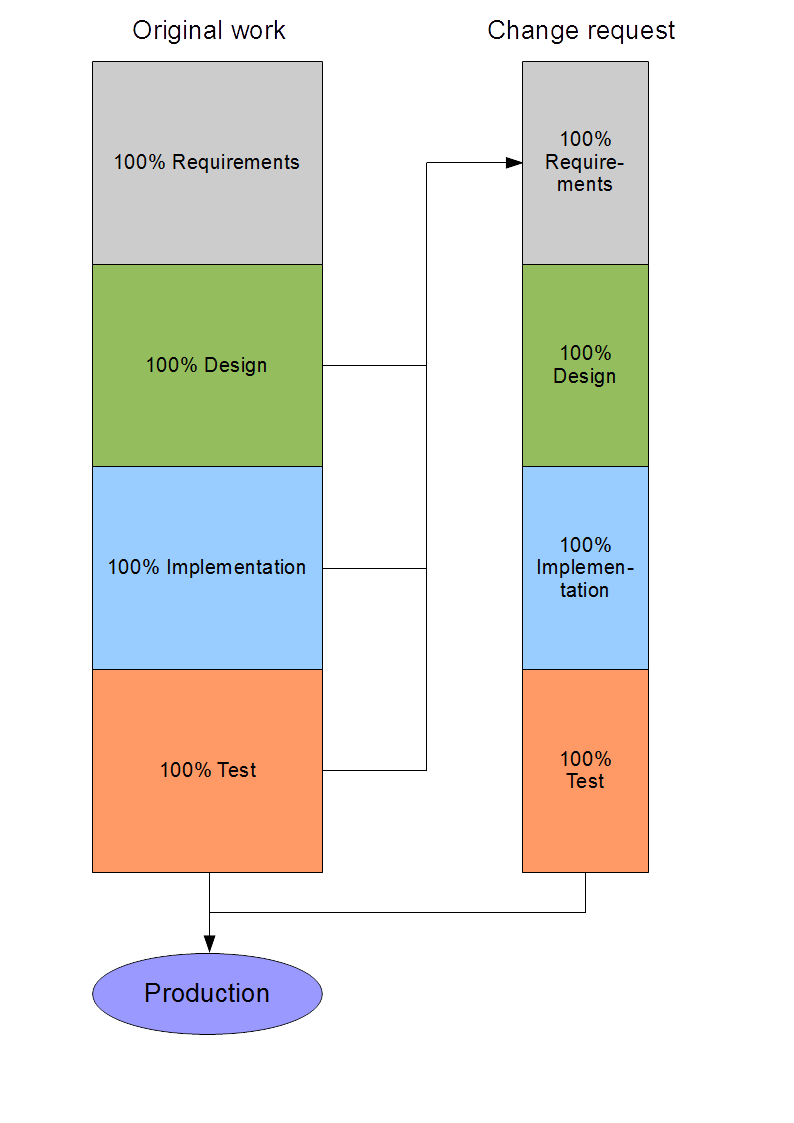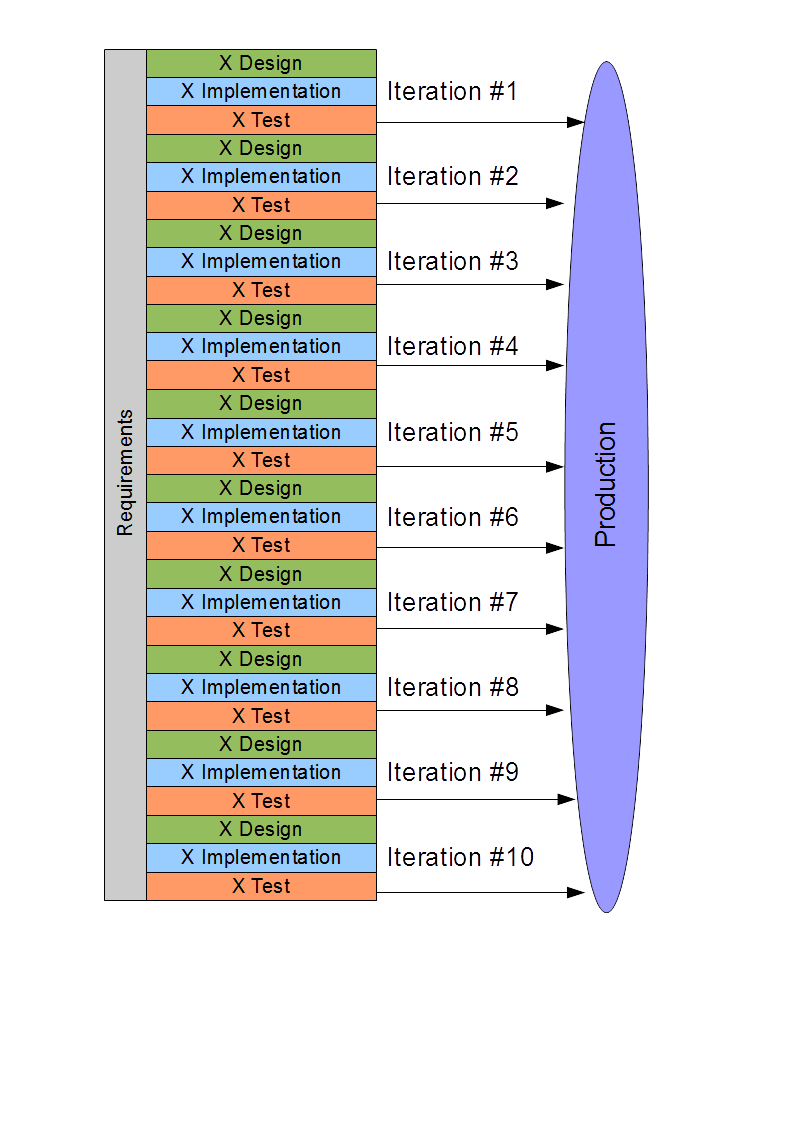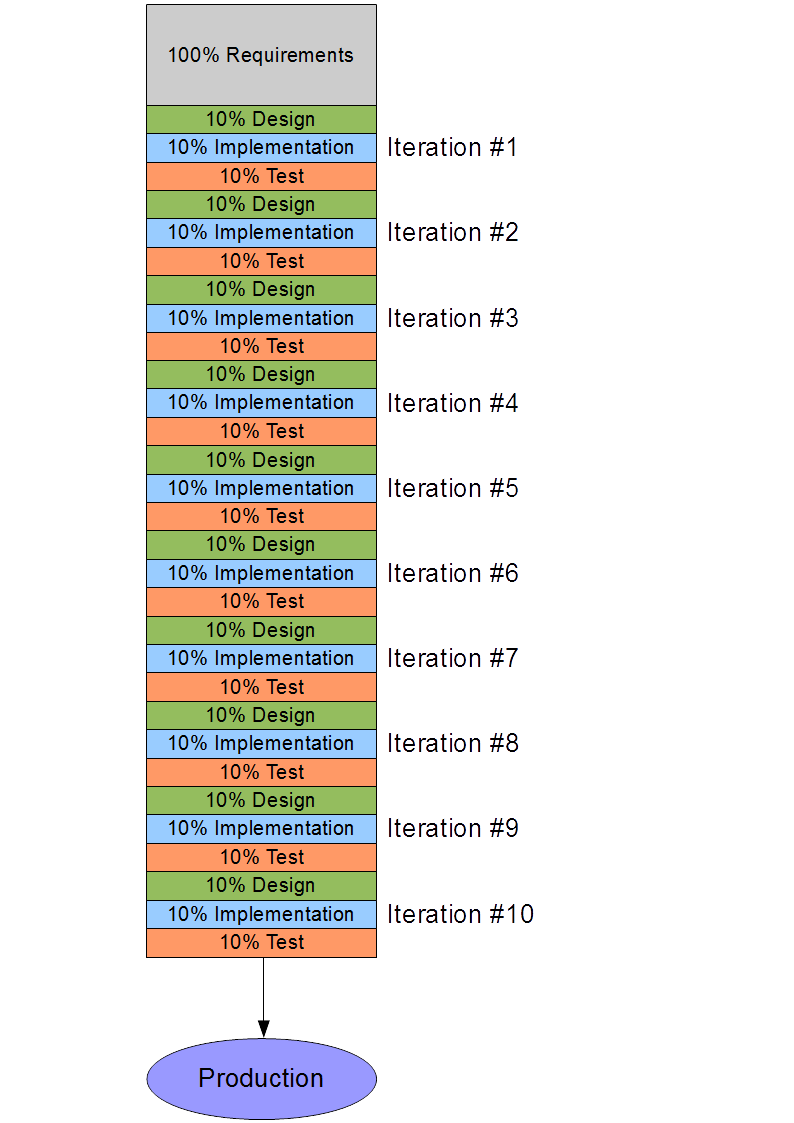Development methodologies are obviously an important part of software development. It is also an area where many developers have strong feelings but not necessarily much evidence about what methodoly is best.
This area is not an exact science, so even though I will try and describe many alternatives with pro's and con's, then this text will also have some subjective evaluations by me. And be aware that I am not an expert in development methodolgies or project management, so my subjective evaluations should not be taken as the one and only truth. But hopefully they will make you think about the problems, realize that this is a very complex topic and make your own conclusions.
The following text will show 4 phases of development:
The waterfall model simply do each of the 4 phases of development sequentially and each phase is completed before moving on to the next phase.
This model is very old. It was described by Herbert Benington in 1956 and Winston Royce in 1970. But it is still widely used.
Requirements are usually documented in a traditional and often very detailed requirements document.
It sort of has a bad reputation. Many developers especially those with little or no experience in larger technical complex projects consider it a major reason for project failures.
An obvious question is what happens if a new requirement show up. That question has two answers.
When someone trying to sell a training course or a book about iterative/agile methodologies describe it, then it is handled by starting all over:

In the real world it is handled by Change Requests (CR). A new or changed requirement show up. It get documented in a CR. It gets discussed by those managing CR's (usually some sort of project steering commitee). If it get approved, then it get done in a separate stream also following a waterfall model.

It is common with many CR's in larger projects. In that case it is normal to group CR's together in a few CR batches and treat each CR batch as separate waterfall instead of treating each CR individually.
So it is actually possible to handle some changes in requirements using waterfall model.
But the CR mechanism does have its limitations. If the number of CR's become too big and especially if the CR's start overlapping each other in functionality, then the project becomes a mess.
Evaluation:
| Criteria | Score | Explanation |
|---|---|---|
| Suitability small-medium sized projects | B | Detailed documentation is not necessary for smaller projects |
| Suitability large-very large projects | A | Detailed documentation scale well to large teams |
| Suitability inhouse projects | A | The stakeholders can get a functional description + schedule for delivery + cost |
| Suitability customer projects | A | The customer can get a functional description + schedule for delivery + cost |
| Suitability fixed requirements | A | When there a few CR's things go smoothly |
| Suitability changing requirements | C | CR mechanism can handle some changes to requirements, but there are limits (see above) |
| Suitability technical simple systems | B | Upfront design is not necessary for techncially simple projects |
| Suitability technical complex system | B | Upfront design is required for technically complex projects, but problems in the design may be found very late |
| Suitability for good teams | B | The process does usually not create much enthusiasm |
| Suitability for mediocre teams | A | The process is easy to understand for the team |
Iterative models are a group of very different models just sharing the characteristic that the work is done in iterations.
Unified Process (UP) was defined by Ivar Jacobson, Grady Booch and James Rumbaugh in 1999.
It split up the development in multiple iterations. Each iteration contain all 4 phases of development.
A special characteristica of UP is that iterations are not necessarily complete. It is possible for a given feature to do requirements in iteration N, design in iteration N+1, implementation in iteration N+2 and test in iteration N+3. As a consequence early iterations contain more requiremenst and design while late iterations contain more implementation and test.
Usage of UP usually involve lots of architecture work and UML disgrams.
The distribution of functionality on iterations is not done based on customer priority but based on technical risk. High risk functionality get done early to allow for sufficient time for redesign in case of problems with design.
Requirements are documented in the form of use cases.
Iterations are typically 4-10 weeks.
The usage of UP sort of got tied to the use of a commercial product to manage the process: Rational Unified Process (RUP). The company Rational got acquired by IBM.
UP/RUP was rather popular back in the early 00's, but has since almost disappeared - replaced by agile and hybrid methodologies.
Iterations are grouped in 4 projects phases:

Evaluation:
| Criteria | Score | Explanation |
|---|---|---|
| Suitability small-medium sized projects | B | Detailed process is not necessary for smaller projects |
| Suitability large-very large projects | A | Detailed process scale well to large teams |
| Suitability inhouse projects | A | Functional description + schedule for delivery + cost usually stabilize early enough to make stakeholders happy |
| Suitability customer projects | B | Functional description + schedule for delivery + cost not fully reliable upfront |
| Suitability fixed requirements | A | Works fine |
| Suitability changing requirements | B | Easy to change requirements for later iterations, but too large changes in scope can create chaos |
| Suitability technical simple systems | B | The amount of architecture and design are not necessary for techncially simple projects |
| Suitability technical complex system | A | The amount of architecture and design plus the early test of high risk functionality is perfect for techncial complex projects |
| Suitability for good teams | A | The process makes sense for the team |
| Suitability for mediocre teams | C | The process is too heavy and too complex for the team |
The spiral model is an old development model first described by Barry Boehm in 1986.
Each cyklus goes through 4 stages:
(last cyklus does not include step 4)
The cyklus get repeated a number of times like:
first prototype -> second prototype -> operational product
It is called the spiral model because it is usually drawn spiralling out from center.
The spiral model is more focused on how the business manage the development process than the actual development process.
It is not used today, so no need to go into much details.
Agile methodologies are a relative broad family of methodologies that share some basic characteristics:
Many agile principles are old, but the it was defined using the term in 2001 by a group of 17 experienced software people including Alistair Cockburn, Martin Fowler, Kent Beck, Robert Martin and Jim Highsmith.
Common characteristics are:
Agile methods can actually be used in two different ways. Which I will label with the terms:
The two concepts are widely known, but the terms I use are not widely used.
What I call "true agile" is where requirements is done for each iteration and there is no defined end goal. Stakeholder provide requirements for iteration, team implements requirements for iteration and that continue until stakeholders consider the solution complete.

Evaluation:
| Criteria | Score | Explanation |
|---|---|---|
| Suitability small-medium sized projects | A | The lightweight process is perfect for these projects |
| Suitability large-very large projects | C | The informal processes does not scale well |
| Suitability inhouse projects | B | Stakeholders like to have functional description + schedule for delivery + cost |
| Suitability customer projects | C | Customers insist on having a functional description + schedule for delivery + cost |
| Suitability fixed requirements | A | Works fine |
| Suitability changing requirements | A | Changing requirements have practically no impact as requirements are done as late as possible |
| Suitability technical simple systems | A | Works fine |
| Suitability technical complex system | C | Not knowing all requirements making it diffucult to create a detailed architecture can result in disaster |
| Suitability for good teams | A | Thrive with the delegation of responsibility |
| Suitability for mediocre teams | B | Things will be forgotten creating unnecessary problems |
What I call "boxed agile" is where requirements are done up front and the end goal is defined. Each iteration implements a part of the requirements.
It is important to note that even though requiremenst are done upfront similar to waterfall, then the requirmenets are typical much less detailed for boxed agile than for waterfall.
Many believers in agile consider this boxed agile model to be a form for waterfall made to look like agile. But non the less it is widely used.

Evaluation:
| Criteria | Score | Explanation |
|---|---|---|
| Suitability small-medium sized projects | A | The lightweight process is perfect for these projects |
| Suitability large-very large projects | C | The informal processes does not scale well |
| Suitability inhouse projects | A | The stakeholders can get a functional description + schedule for delivery + cost |
| Suitability customer projects | A | The customer can get a functional description + schedule for delivery + cost |
| Suitability fixed requirements | A | Works fine |
| Suitability changing requirements | B | Requirements are done upfront, but changing them is not so bad as the requirements are high level |
| Suitability technical simple systems | A | Works fine |
| Suitability technical complex system | B | Architecture is usually rather high level so problems can arise |
| Suitability for good teams | A | Thrive with the delegation of responsibility |
| Suitability for mediocre teams | B | Things will be forgotten creating unnecessary problems |
The original manifesto:
We are uncovering better ways of developing software by doing it and helping others do it.
Through this work we have come to value:
That is, while there is value in the items on the right, we value the items on the left more.
The original 12 agile principles:
eXtreme Programming (XP) was defined by Ken Beck in 1999.
Requirements are done in the form of user stories.
XP does not use any upfront design. In case of doubt a POC called a Spike can be done.
Key characteristics of development include:
Iterations are typical 2 weeks.
XP was very popular around 2000-2002, but is very rare today.
The history of Scrum goes back to 1986 where Hirotaka Takeuchi and Ikujiro Nonaka described the process for physical product development. It was defined around 1995 for software by Ken Schwaber and Jeff Sutherland.
Scrum defines 3 primary roles:
Iterations called sprints are typical 2 weeks.
Requiremenst get into the requirement backlog and each iteration/sprint take a number of those.
A key element is the daily 15 minutes standing meeting called scrum where status is presented.
Scrum is very widely used today. In some circles agile and Scrum has almost become synonyms.
Kanban history goes back to mid 1980's where Taichi Ohno developed it for manufacturing as part of lean/JIT manufacturing. In the late 2000's it became extended to software development. Kanban in some ways build on Scrum.
Kanban visualize workflow using a Kanban Board. For software development the columns can be the traditional:
Kanban key principles are:
Kanban had become used a lot in recent years.
Scrumban is a hybrid of Scrum and Kanban.
It uses a Scrumban board with:
There are also 3 buckets:
There is a WIP (Work In Progress) minimum and maxium.
When number tasks in Doing status goes below WIP minimum planning is triggered and tasks are moved from ToDo to Doing status.
Iterations are short just a few weeks, but are not fixed.
The planning also moves tasks from 3 monbth bucket to ToDo status.
Projects in 6 months bucket becomes tasks in 3 months bucket when requirements are done.
Ideas in 12 months bucket becomes projects in 6 months bucket when business decide it is a go.
No special roles defined.
Experience with agile for small projects has been very good.
But agile does not scale.
Many agile proponents may deny that, but some of the items in the agile manifest and principles simply work better for small teams than for large teams.
Specifically:
It is true that developer A talking to developer B is more effective that written documentation.
But in the real world it works like:
| Team size | Location | Direct communication |
|---|---|---|
| 10 | same room | great |
| 100 | multiple rooms same building | bad |
| 1000 | multiple buildings | impossible |
So as a result several methodologies that are hybrids of agile and other methodologies especially UP has been created to try and handle this problem as good as possible.
They all try to keep as much of the good things from agile while adding more structure to work for larger teams.
The hybrid methodologies are usually closer to "boxed agile" than "true agile".
Evaluation (assuming boxed agile style):
| Criteria | Score | Explanation |
|---|---|---|
| Suitability small-medium sized projects | B | Too much process for these projects |
| Suitability large-very large projects | A | This is the problem they solve |
| Suitability inhouse projects | A | The stakeholders can get a functional description + schedule for delivery + cost |
| Suitability customer projects | A | The customer can get a functional description + schedule for delivery + cost |
| Suitability fixed requirements | A | Works fine |
| Suitability changing requirements | B | Requirements are done upfront, but changing them is not so bad as the requirements are high level |
| Suitability technical simple systems | A | Works fine |
| Suitability technical complex system | B | Architecture is usually rather high level so problems can arise |
| Suitability for good teams | B | Too much democracy and too little meritocracy |
| Suitability for mediocre teams | B | Things will be forgotten creating unnecessary problems |
SAFe (Scaled Agile Framework) was described by Dean Leffingwill in 2011.
SAFe comes in two flavors:
3 level SAFe consist of:
4 level SAFe consist of:
Critics consider it more UP than agile.
DAD (Disciplined Agile Delivery) is created by Scott Ambler while working for Rational/IBM. It started as AUP (Agile UP) in 2006 and ended up in its current form as DAD in 2012.
It is a more discplined approach to agile suitable for larger projects.
DAD split project in 3 phases (UP has 4 phases as described above):
Inception is focused on planning and architecture.
Construction is focused on development including test.
Transition is focused on final test and deployment.
DAD also like UP prioritize doing critical complex development early to reduce risk.
Again critics consider it more UP than agile.
LeSS (Large Scale Scrum) was defined by Craig Larman and Bas Vodde in 2013.
LeSS has two levels:
The teams in LeSS are simply Scrum teams. And the structure on top tries to follow Scrum principles. Each teams sprints are synchronized.
Smaller LeSS:
Huge LeSS:
LeSS is less UP than the previous two.
Comparison of scores:
| Criteria | Waterfall | UP | True Agile | Boxed Agile | Hybrid |
|---|---|---|---|---|---|
| Suitability small-medium sized projects | B | B | A | A | B |
| Suitability large-very large projects | A | A | C | C | A |
| Suitability inhouse projects | A | A | B | A | A |
| Suitability customer projects | A | B | C | A | A |
| Suitability fixed requirements | A | A | A | A | A |
| Suitability changing requirements | C | B | A | B | B |
| Suitability technical simple systems | B | B | A | A | A |
| Suitability technical complex system | B | A | C | B | B |
| Suitability for good teams | B | A | A | A | B |
| Suitability for mediocre teams | A | C | B | B | B |
| Version | Date | Description |
|---|---|---|
| 1.0 | October 1st 2017 | Initial version |
| 1.1 | February 16th 2025 | Add Spiral and Scrumban sections |
See list of all articles here
Please send comments to Arne Vajhøj